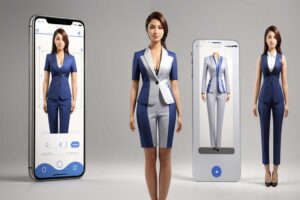The evolution of body measuring in the fashion industry is an exciting development, fueled by technological advancements that promise a future where made-to-measure clothing is accessible and sustainable. This shift is largely driven by consumers’ increasing demand for size inclusivity and garments that reflect their unique tastes, alongside a broader commitment to reducing environmental impact
Historical Context

Historically, bespoke tailoring involved extensive fittings and adjustments by skilled tailors to achieve the perfect fit. This meticulous process was time-consuming and costly, reserved for those who could afford such luxuries. With the advent of mass-produced clothing, bespoke tailoring became less common, overtaken by the convenience and affordability of ready-to-wear options.
Resurgence of Custom Clothing
However, the landscape is changing once again. The rise of fast fashion has led to significant waste—over $150 billion in returned clothing last year alone—prompting a renewed interest in bespoke and made-to-measure garments. This interest is further driven by a desire for clothing that genuinely fits and represents individual consumers, coupled with an emphasis on sustainable fashion practices.
This evolution not only meets the growing consumer demand for personalized garments but also supports the industry’s shift towards more sustainable practices.
The Role of Technology in Tailoring
Technology is playing a pivotal role in transforming traditional tailoring practices. Here’s a look at how tech is redefining the way measurements are taken, enhancing both accuracy and convenience:

1. 3D Body Scanners
- Functionality: 3D body scanners capture a person’s measurements by creating a detailed 3D model. This technology provides precise data on body measurements, posture, and other physical attributes, significantly reducing the need for physical fittings.
- Limitations: Despite their precision, these scanners are expensive and bulky, requiring the physical presence of the customer, which can be inconvenient and costly.

2. Mobile Body Scanning
- Advancements: Recent developments in AI, computer vision, and deep learning have led to the creation of mobile body scanning technologies. These systems allow customers to take a few photographs which are then processed to deliver accurate body measurements within minutes.
- Benefits: Mobile body scanning offers a more accessible, convenient, and cost-effective solution compared to traditional methods. These systems enable customers to measure themselves anywhere, integrating seamlessly with made-to-measure businesses.
- Impact: The technology not only streamlines the measurement process but also provides valuable consumer data, such as body shapes and demographic segmentation, which can help brands better understand and cater to their clientele.
3. Integration with Fashion Design Software
- Capabilities: Some mobile scanning solutions, like the Mobile Tailor from 3DLOOK, provide businesses with over 80 points of measurement from just two photos. This data can be integrated directly into 3D fashion design software, allowing for accurate and efficient design processes.
- Customer Experience: This technology enhances the customer experience by reducing the time and hassle associated with traditional fitting sessions, aligning with the needs of tech-savvy consumers who value convenience and precision.
The Future of Made-to-Measure Fashion
The integration of these technologies into the fashion industry signals a significant shift towards more personalized, sustainable, and consumer-centric fashion practices. As mobile body scanning becomes more widespread, it will likely disrupt traditional sizing systems, reduce return rates, and help brands differentiate themselves by offering unique customer experiences.










